
Canned Vegetables: Healthy or Unhealthy?
Are canned vegetables healthy? This is a common question at Dietetic Directions, especially prevalent this time of year as we transition out of summer and into fall harvest. Different vegetables are available such as potatoes, squash, carrots, beets and cabbage. Unfortunately, many of our favourites like peaches, green beans and corn on the cob are no longer in season. Nevertheless, canned vegetables and legumes can be a healthy and affordable alternative. In case you missed it, you can also opt for frozen vegetables – see past blog, Are Frozen Vegetables Better than Fresh?.

Today, let’s break down the canning process and discuss the nutritional considerations of consuming canned vegetables versus fresh. I’ll share my favourite recipes using canned foods and address health and safety of BPA as well as storage and shelf-life.
P.S. Thanksgiving is coming! Have you donated canned foods to your local food bank? Let’s all go for it. Donating food takes minimal time and is a great way to help your community during the upcoming holiday season.
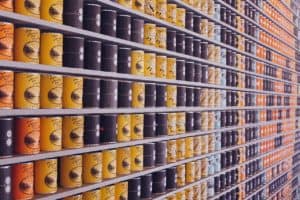
What is Canning?
Canning is a preservation method to protect food from contamination and spoiling. Fruits and vegetables are usually canned within hours of picking and follow a 3-Step Process described below:

The 3-Step Canning Process:
1. Processing: To prepare fruits and vegetables for canning, they must be washed and often peeled, pitted or chopped. Blanching or submerging the food item in boiling water and then a cold water bath helps maintain flavour, colour, texture and nutritional value before canning or freezing. Next, water, oil or juice fill the cans.
2. Sealing: The lid of the can is then sealed air-tight to ensure food safety and prevent contamination. Sealing the can keeps out air and any microorganisms that could potentially contaminate and/or spoil the food.
3. Heating: The last phase in canning is to heat the sealed can to a specific temperature for a certain amount of time. This kills any bacteria and prevents spoiling. The cans are then quickly cooled.
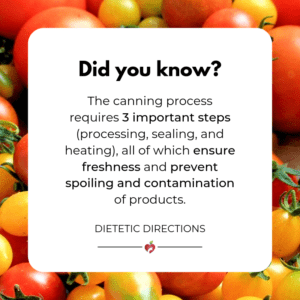
Benefits of Canned Vegetables
- Super Fresh: Produce is picked at peak freshness and preserved soon after. Generally, the less distance food travels, the fresher it stays, since it is picked at the height of nutrition.
- Great Nutrition: The amount of minerals, fat-soluble vitamins, protein, fat and carbohydrate remain relatively unchanged in the canning process. The heating process can even increase antioxidant content such as lycopene in canned tomatoes.

- Convenient: No cooking required. Rinse canned food before use (to decrease salt content.) Open up a can of chickpeas or beans, for example, and add them to meals or snacks.
- Long-Lasting: Canned foods are also shelf-stable, which means you can stock your pantry for quick meals when you’re short on time.
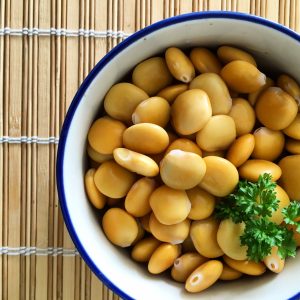
Speaking of being short on time… have you ever heard of lupini beans? I love to snack on these on the go – learn more lupini nutrition and about power snacking in these past blog posts.
- Affordable: Who doesn’t love to save money? Save money with canned alternatives and boost your vegetable and fibre intake simultaneously. Try adding canned pumpkin to your favourite chili recipe (see my Savoury Pumpkin Chili recipe) or rinse off canned artichokes to add to quinoa or pasta salad.
- Less Food Waste: Opting for canned alternatives means that you can open and use then whenever you’re ready. Opting to buy canned food takes away the stress of using food up immediately.
- Choose Local: Who doesn’t love to support our local Canadian farmers? Check the food label to see where your canned food is from and buy local when possible!

Considerations of Canned Foods
- Watch The Salt: Opt for canned foods without added salt (when possible) or choose reduced salt options. Thoroughly rinse foods such as chickpeas to remove preserving salt and liquid. Check the nutrition label and look for 200mg of sodium or less per serving.

- Consider Preserving Liquid: Try to opt for foods canned in water and skip the added sugars in canning syrups or juices.
- Check for Limited Ingredient List: Take a peek at the ingredients and avoid cans with long lists. It’s normal to find preservatives like ascorbic acid (aka. Vitamin C) to copheral (aka. Vitamin E), and acetate (used as a food antioxidant), which are all safe ingredients to consume.
Speaking of food labels… want to become a savvy food label reader? Check out this blog post on Nutrition Facts and Label Reading for some helpful tips and tricks!
- Watch The Look! Avoid cans with dents, bulges or cracks. This could indicate bacteria contamination that causes botulism, a serious illness. This is not overly common in commercially canned products but can be a concern in home canned products.
Favourite Recipes with Canned Vegetables:
1. Lentils – Greek Lentil Salad

2. Chickpeas – Rosemary Roasted Chickpeas
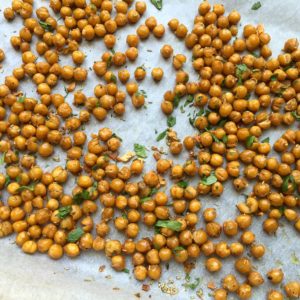
Canned Pineapple – Naan Pizza

Canned Fruit – Easiest Fruit Salad

Romano Beans – Italian-Style Romano Beans
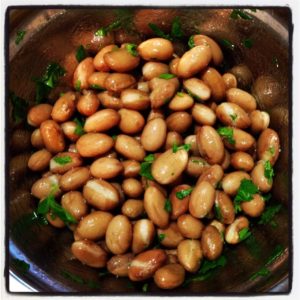
Canned Tomatoes (no salt added) –Homemade Tomato Sauce
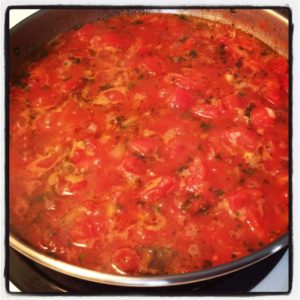
Canned Pure Pumpkin – Savoury Pumpkin Chili
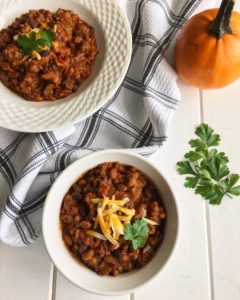
How to Store Canned Foods:
- Store Properly: Store canned foods in a cool and dry place – away from pipes, stove, furnace or direct sunlight.
- Use Within Recommended Time: Food manufacturers generally recommend storing canned goods for no longer than one year. Use canned tomatoes within 18 months, and store low-acid foods like canned vegetables for up to 2 to 5 years.
- Transfer Properly: When you open canned vegetables, transfer unused vegetables to an airtight container and store in the fridge for 3 to 4 days. Don’t continue to store opened cans in the fridge.
- Freeze: If you prefer, you can freeze leftover canned veggies for up to 2 months.
- Use FIFO (First in First Out) System: Ensure older cans get used first before recently purchased items.
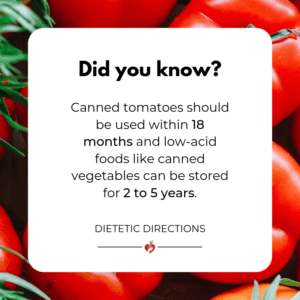
What about BPA in Cans?
BPA (bisphenol A) is an industrial chemical used to make hard, clear plastics (also known as polycarbonate). Reusable hard water bottles and some baby bottles may contain BPA, as may the lining inside metal cans such as canned foods.
Did you know? BPA (bisphenol A) is a chemical that is added to many commercial products, including food containers, hygiene products and baby bottles.
Health Canada conducted a 2010 survey entitled Survey of Bisphenol A in Canned Food Products from Canadian Markets. This survey examined samples from 78 different canned food products, and found only low levels of BPA. Consequently, the results of this survey confirm that exposure to BPA from canned food products is very low and poses no health or safety concerns to the general population.
To encourage you to not skip your canned chickpeas, lentils and salmon, Health Canada has been investigating BPA consumption and health and set a tolerable upper limit for BPA at 25ug/kg of body weight. In this 2012 Risk Assessment of BPA, the average intake of population was 0.043 ug/kg. Therefore, they state, “for most Canadians, BPA does not pose a health risk because our exposure to the chemical is very low.”
“For most Canadians, BPA does not pose a health risk because our exposure to the chemical is very low.”
Health Canada, 2010
To read more about BPA amounts in specific foods click here.
It is important to stay abreast of the latest information and use personal caution and discretion. Choosing BPA-free water bottles or opting for BPA-free products is an alternative. However, fear-mongering about the link between occasional consumption of canned food and cancer is not warranted based on the current research.
Nevertheless, if you are wanting to reduce your BPA intake:
- Choose stainless steel water bottles.
- Store foods in glass containers and not plastics that contain BPA.
- Refrain from providing children with products (like bottles, cups or tins) that contain BPA.
- Buy, soak, and cook your own beans or put them in a pressure-cooker to heat and or buy frozen.
- Can and freeze your own tomatoes and vegetables in glass jars.
Bottom Line:
Canned vegetables, legumes and fruits are another healthy option to include in your diet. The nutrition is generally intact, and the produce is super fresh when canned. Also, including canned options in the diet allows for a convenient, cost-effective and versatile option to boost vegetable or legume intake. However, be mindful of salt content and added sugars and choose products that have short ingredient lists. What’s more, the BPA amounts in canned vegetables and legumes are something to be aware of but not worried about based on the current intakes and best available research. Finally, good nutrition and eating well are all about balance. Enjoy eating a variety of foods (fresh, canned, frozen, etc), cook more at home and minimize processed foods and eating out.

Now it’s your turn! Which of your favourite foods do you choose as canned alternatives? Do you have pantry staples you like to keep on hand?


